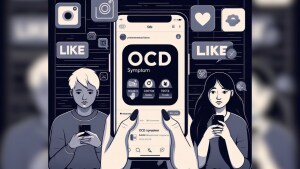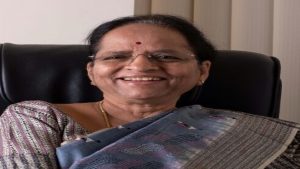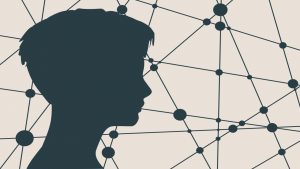The rise of pop psychology and mental health advice on short video platforms — a quick fix or folly

KV Prasad Jun 13, 2022, 06:35 AM IST (Published)
 Listen to the Article (6 Minutes)
Listen to the Article (6 Minutes)
Summary
As the mental health crisis deepens, a unique trend is emerging, primarily on short video platforms such as TikTok (in the West). The spotlight now shifts to these digital platforms, where self-proclaimed experts and influencers offer guidance on mental well-being. The popular hashtags #mentalhealthawareness and #mentalhealthadvocate garner millions of posts, uniting individuals with a shared curiosity and a desire to improve their understanding of the issue. However, within this sea of content creators, a vital question emerges: How reliable is the guidance offered by these digital influencers?
If you are on Instagram, chances are high of being besieged with viral Instagram reels of the F.R.I.E.N.D.S character Monica going frantic over perfectionism with the subtext, ‘You have OCD if you do this’ — or videos where a famous influencer vlogs about their day in one minute, blaming their reactions to situations on ADHD (Attention Deficit/Hyperactivity Disorder).
We’ve all been through times when we’re not feeling well, experiencing symptoms that prompt us to consult Google. In the vast world of search results, it’s easy to fall into the rabbit hole of self-diagnosis and anxiety. Sometimes, this phenomenon extends beyond physical ailments and dives into the realm of mental health, and videos on short video platforms (such as TikTok in the West) are playing an unexpected role here.
The World Health Organization (WHO) notes that 56 million Indians grapple with depression and anxiety disorders.
Instagram reels and YouTube shorts
Digital platforms are flooded with self-proclaimed experts and influencers who offer guidance on mental well-being. Hashtags #mentalhealthawareness and #mentalhealthadvocate garner millions of posts, uniting individuals with a shared curiosity and a desire to improve their understanding of mental health.
The data highlights a compelling trend. A survey by Hall & Partners, published in February 2023 encompassing 10,000 participants worldwide, reveals that over 59 million Americans sought health-related advice from TikTok and Instagram influencers. This trend was particularly pronounced among younger generations, with one-third of Gen Z and over a quarter of millennials turning to these platforms for insights into chronic conditions and health dilemmas. In contrast, only 5% of baby boomers explored this digital landscape for the same reason.
Within this sea of content creators, a vital question emerges: How reliable and accurate is the guidance offered? In a world where algorithms intersect with human emotions, the answers are as intricate as the individuals seeking them.
What kind of mental health advice are people getting from social media?
People often turn to social media for various forms of advice, including mental health guidance, dating tips, and advice on handling workplace stress. However, it’s important to recognize that the advice dispensed on these platforms may not be universally applicable. One-minute videos or brief posts cannot adequately address complex issues, and they can inadvertently fuel confirmation bias. This confirmation bias occurs when individuals already have a theory or belief, and they seek out content that reinforces it, potentially leading to hasty labels like narcissism or introvert behavior. Additionally, self-diagnosis based on limited online advice can be problematic, as it may not provide a holistic understanding of an individual’s unique circumstances and challenges.
According to Dr Sangeetha Reddy, a consulting psychologist based out of Hyderabad often people watch these advises and self diagnose themselves thinking that if ‘A’ person is going through something which they are also going through then both of them have same mental health issues, or if ‘A’ person is giving advises on how to manage trauma, or become outspoken then following that can help them as well which is not true.
“People should avoid any creator providing a ‘treatment’ for mental health as it’s not a one-size-fits-all concept. People should absolutely not self-diagnose on the basis of someone else’s personal experience. Yes self-help content is useful but that’s not the only solution and that cannot be a knowledge that you can acquire in a minute,” she added.
Why are people turning to social media for mental health advice?
“I have been diagnosed with mild anxiety and depression and at times I often turn to social media and willingly search for mental health videos just to feel that I am not alone. I look at the comment section and there is a sense of community,” said 19-year-old Diksha Sharma.
Twenty-year-old content creator Taneesha Mirwani also feels that since mental health, in general, is stigmatised, ‘social media therapy’ on short video platforms is often one of the only sources younger individuals have access to.
Experts say one reason for this can be the openness the platforms provide.
“With social media more and more people are talking about mental health, so many individuals tend to get attracted to such videos because they feel they are not alone. Those who might be feeling alone in their struggle might feel that they are getting the validation that they need on social media,” said Dr Reddy.
According to a 26-year-old content creator, Robin Kurian, short and edible pieces of content seem easier to consume and follow than reading up or going to therapy. Hence, people often end up following mental health advice as they hop on a social media trend.
Users are seeking bite-sized information presented to them in a minute or less to diagnose their symptoms and even find solutions. While reducing stigma, the surge in online mental health inquiries has spawned ‘pop psychology,’ which offers simplified advice for mental health but is often not scientifically backed.
The rise of pop psychology and why people follow it on social media
“People seem to think that psychology is all about band-aid situations. Like do xyz and you’ll be cured, but that is never the case. Mental health problems are unique to every individual. Stress for instance may be a common concern but the circumstances are always different. There is no one solution to stress unlike what pop psychology says. People want ‘fast’ relief, which is why pop psychology is popular,” said 26-year-old Divija Bhasin, who is counselling psychologist, content creator and founder of mental health organisation called The Friendly Couch.
Another reason behind this is the sense of relatability, according to 25-year-old content creator Prableen Kaur Bhomrah, Pop psychology videos often feature real stories and personal experiences, creating a profound sense of connection among viewers.
“This relatability allows understanding and empathy, making people more receptive to the advice and insights shared. The designation of mental health is another crucial factor. Pop psychology videos contribute significantly to breaking down societal taboos around mental health issues. By addressing these topics openly and candidly, these platforms normalise conversations about mental health,”
Apart from accessibility and relatability, another factor that prompts people, especially the younger audience, to seek social media therapy, thus leading to an explosion of pop psychology, is that social media is everywhere. According to Dr Reddy, youngsters use social media for everything. “You’ll find almost every youngster nowadays active on social media platforms, it’s not just a platform to share content, it’s now way more than that,” she added.
But how reliable is actually taking mental health advice from social media?
Social media therapy — information or misinformation?
Of course, there is a plethora of content creators putting out mental health content on social media — but is the content information or misinformation. According to Bhasin, pop psychology may make people aware of mental health as a concept, but the concept is deeply flawed and not what actual mental health is all about.
“It is harmful to individuals because they start to self-diagnose or use labels without any actual evidence, which can cause even more anxiety. I have witnessed this happen in real life with my clients,” she added.
ALSO READ | Meta’s social platforms are addictive and harm children’s mental health, claim 33 US states in lawsuit
A recent study PlushCare published in November last year, globally, the huge majority of mental health advice on TikTok — approximately 83.7% — may not be reliable. Additionally, about 14.2% of the videos contain content that could be harmful.
The study also discovered that only 9% of individuals offering mental health guidance on TikTok had proper credentials.
Another study featured in the Canadian Journal of Psychiatry found that 52% of the top 100 TikTok videos discussing ADHD were found to be inaccurate or misleading.
As per experts, yet another critical issue with pop psychology is that it trivialises the real struggles of people who have disorders. With the rise of pop psychology people often start to self-diagnose and don’t actually know when they need professional help.
“Another harm is that people start trivialising the work of mental health professionals and assuming that the problems are self-treatable. This stops people from getting the professional help they need, making their problems more difficult to treat when they actually go to professionals,” added Bhasin.
Further, a study of 2,000 US adults, released in December from CharityRx, showed that 33% of Gen Zers trust TikTok more than their physician. While another 44% turn to YouTube before turning to their doctor.
Meanwhile, according to Dr Reddy, the problem with pop psychology is in the trend itself. “Putting out mental health content, or just putting a perfectionist video with a title ‘Things you’ll relate to because you have OCD’ is trendy on social media, and as it favours the algorithm, many content creators jump to this without doing proper research, resulting in trendy videos in the name of mental health advice
“People tend to believe things that aren’t true because someone relatable to them said it. They trust personal experience more than experts with fancy degrees and scientific articles. This relatability can hold more importance for some than the credentials of a medical doctor or a PhD supported by scientific research. The power of personal experience and connection that comes with social media drive people to content creators on mental health rather than to professionals.
How to verify mental health advice on social media
Experts say if the content doesn’t derive from personal experience, like a mental health struggle that a creator faced, and also is something about a particular disease or symptoms, then one should make sure to check if the psychology content is being made by a real psychologist.
So it’s best to check if the adviser has completed the minimum qualification of a master’s degree in psychology. If their qualifications are not on their Instagram page, one can find them on LinkedIn.
“Lastly, please don’t follow content that sells you something to treat your mental health and take actions,” said Dr Reddy. No tea, masala, gummies, candy perfume etc. can ‘cure’ your mental health. There are remedies that help in improvement and healing, but that takes time. Even for that please talk to a professional before taking any actions, she added.
The role of creators
As pointed out by Dr Reddy, just to feed the algorithm frenzy, people tend to put out information on mental health which is not scientifically true. Being a content creator comes with a lot of responsibility especially when it comes to talking about topics like mental health.
Aastha Shah, herself a digital content creator, advises creators to thoroughly do their research before putting out any content on the topic, and also provide the sources used in the description.
Meanwhile, Mirwani recommends that if the creators are speaking about their own experience or what helped them, they always need to specify that this was their personal experience — which may or may not apply to whoever is watching.
“Also, content creators should be free to put out whatever content they want, but should always put a disclaimer that they are not a professional when talking about topics that would be most reliable coming from an expert,” she added.
Talking about the kind of content that creators put out, Bhomrah suggests that
creators should prioritise their language when discussing mental health, and avoid stigmatising words and embracing positive and empathetic communication to help reduce the stigma. They should also reflect the diversity of mental health experiences in their content, considering cultural, gender, and background differences. Providing links to reputable mental health resources and hotlines in video descriptions is crucial
“Furthermore, content creators should be cautious about potential triggers in their discussions, using warnings for sensitive topics and allowing viewers to prepare or skip distressing content, thus fostering a more considerate and supportive environment for mental health conversations,” she said.
Further, Bhasin says that mental health professionals should be the only ones giving out mental health information, unless it is about lived experiences.
“Content creators can help by giving a platform to mental health professionals who can give out verified information. Mental health professionals can also teach creators how to understand and read information that is evidence-based, which is a skill that everyone does not have,” she added.

Elon Musk forms several ‘X Holdings’ companies to fund potential Twitter buyout
3 Mins Read
Thursday’s filing dispelled some doubts, though Musk still has work to do. He and his advisers will spend the coming days vetting potential investors for the equity portion of his offer, according to people familiar with the matter

KV Prasad Journo follow politics, process in Parliament and US Congress. Former Congressional APSA-Fulbright Fellow










 Listen to the Article
Listen to the Article  Daily Newsletter
Daily Newsletter
























